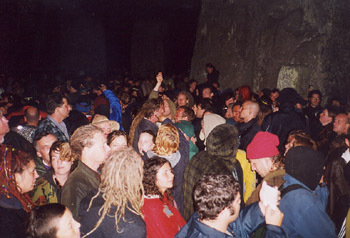
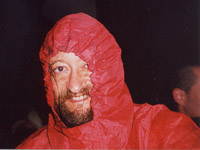
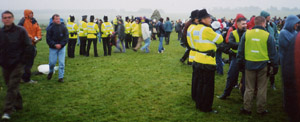 Nobody knew how it
was going to go. Even after fifteen years there were
still a lot of people with very hard feelings after the violence of The
Battle Of The Beanfield, and scores to settle against the police, and
the possibility of it all kicking off was very real. Many of the
organisers on the druid side (including me) suspected that the
authorities wanted a fight to start, so that they could justify closing
it for another couple of decades.
Nobody knew how it
was going to go. Even after fifteen years there were
still a lot of people with very hard feelings after the violence of The
Battle Of The Beanfield, and scores to settle against the police, and
the possibility of it all kicking off was very real. Many of the
organisers on the druid side (including me) suspected that the
authorities wanted a fight to start, so that they could justify closing
it for another couple of decades.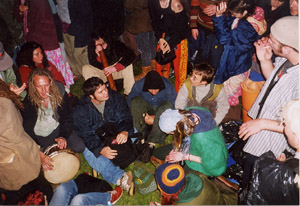 The
public were allowed in at ten o'clock and after passing through a
police corridor entered the area under a staff arch held aloft by King
Arthur and
Rollo Maughling. Although some set up small camps on the grass
outside
the stones, most headed straight for the circle. Soon the centre of the
stones was densely packed with drummers, didgeridoo players,
pipers and
other musicians, so much so that it was difficult to move elbows. They
struck up a powerful hypnotic beat and kept it
going all night, from the hour they were allowed into the stones until
the following day when police cleared the area at noon. Outside of that
intense percussive core the human density gradually diminished as the
psychic gravity became weaker, and within the remains of the outer
ditch and bank movement was quite easy.
The
public were allowed in at ten o'clock and after passing through a
police corridor entered the area under a staff arch held aloft by King
Arthur and
Rollo Maughling. Although some set up small camps on the grass
outside
the stones, most headed straight for the circle. Soon the centre of the
stones was densely packed with drummers, didgeridoo players,
pipers and
other musicians, so much so that it was difficult to move elbows. They
struck up a powerful hypnotic beat and kept it
going all night, from the hour they were allowed into the stones until
the following day when police cleared the area at noon. Outside of that
intense percussive core the human density gradually diminished as the
psychic gravity became weaker, and within the remains of the outer
ditch and bank movement was quite easy.
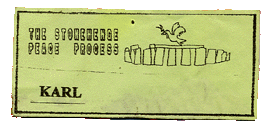 There was police security. There was private security paid for
by
English Heritage. There were Peace Stewards organised by
George Firsoff of The Stonehenge Peace Process
(including Daibh Green and myself - that's my old badge on the left).
It poured down with rain nearly all night. In the
morning the sun didn't even rise because the sky was completely
overcast. But it was peaceful and it was a success, and it was a great
way to start the 21st century.
There was police security. There was private security paid for
by
English Heritage. There were Peace Stewards organised by
George Firsoff of The Stonehenge Peace Process
(including Daibh Green and myself - that's my old badge on the left).
It poured down with rain nearly all night. In the
morning the sun didn't even rise because the sky was completely
overcast. But it was peaceful and it was a success, and it was a great
way to start the 21st century.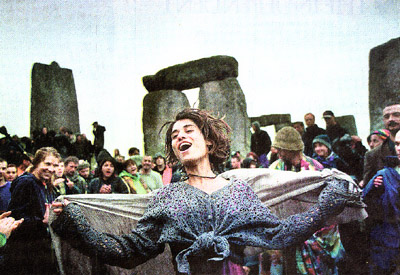
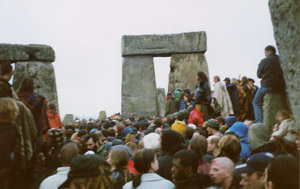 Greeting
the dawn
Greeting
the dawn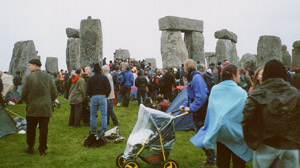
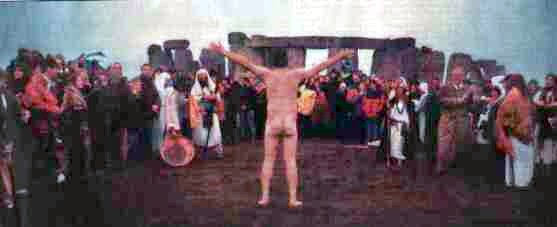
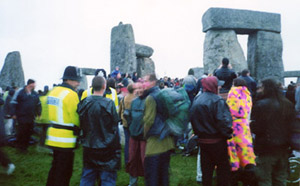
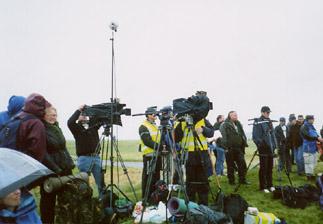
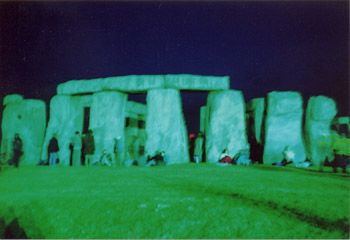 Stonehenge
2001
Stonehenge
2001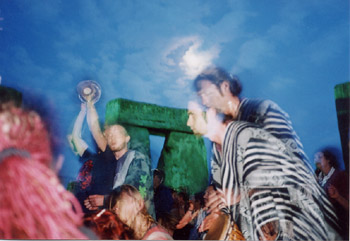
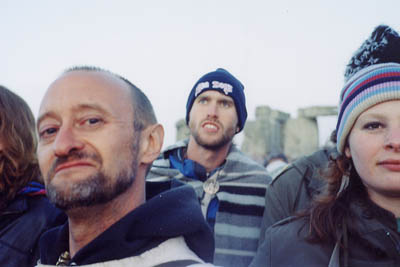 Lugodoc at Stonehenge 2004
Lugodoc at Stonehenge 2004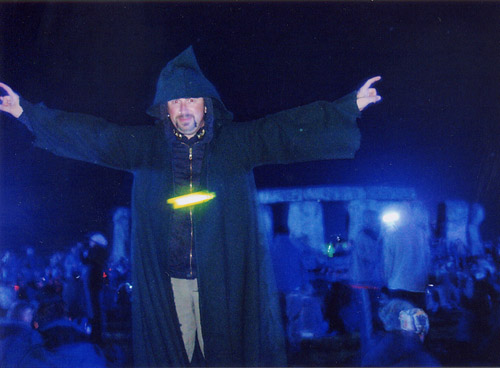 Daibh at Stonehenge 2006
Daibh at Stonehenge 2006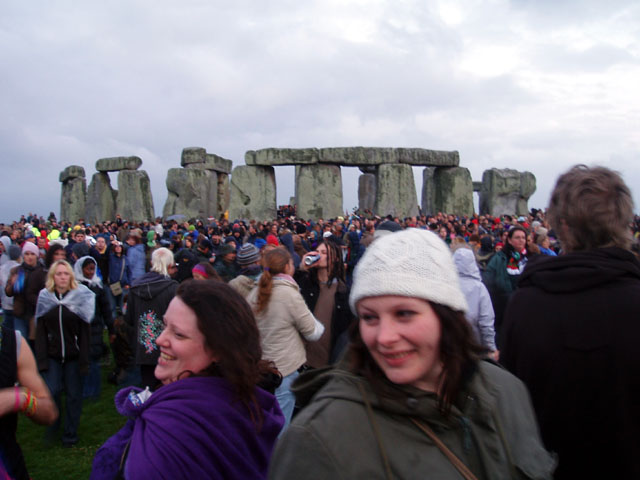
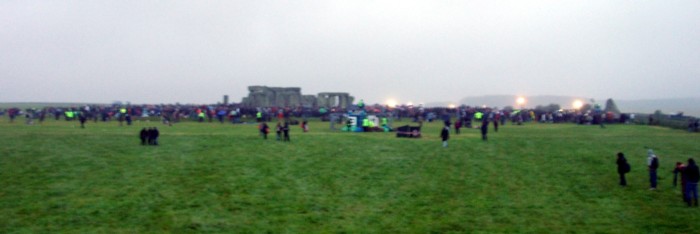 Stonehenge 2008
Stonehenge 2008Police surveillance drone
(photo taken by this author) |
2009 The police presence at Stonehenge had been getting less intrusive every year since 2000 and was truly minimal in 2008, but that all changed in 2009. It seems that the new Chief Constable of Wiltshire, Mr Brian Moore, was unhappy about the trouble-free celebrations of previous years and had decided that in 2009 he wanted more arrests in order to "send a message", so this year there were hundreds of police with horses, sniffer dogs and even a remote piloted aerial surveillance drone. Midsummer Eve fell on a Saturday night for the first time since 2003 (when this author was at Avebury) and consequently the stones were heaving. An estimated 35,000 revellers arrived in three continuous streams from North, East and South between 8 p.m. and 4 a.m. and the crowd was the densest this author remembers. About 31,000 were there last year prompting 12 arrests for minor offences, mainly drugs. This year there were 37 arrests and the costs of the police operation have not been made public. After all that Chief Constable Moore never actually said what the message was, but it sounded like "I have been given money to burn". |
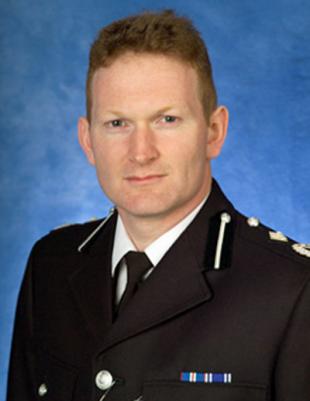 Brian Moore
(publicity photo) |
|
Stonehenge 2010 Yet again not a perfect sunrise like 2005, but the sun rose above low cloud only a few minutes late and then the day was glorious. Those first rays were captured by professional photographer Duncan Knifton, a friend of Lugodoc on his first pilgrimmage to the stones. He works from The Mobile Portrait Studio (019 8352 8573 - Gunville Road, Newport, Isle of Wight, PO30 5LB) |
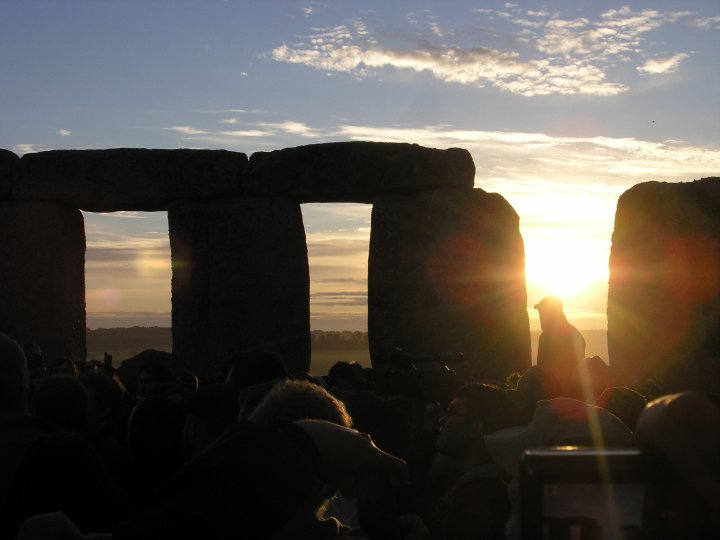 © Duncan Knifton 2010 |
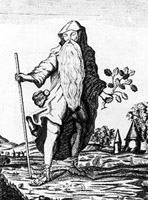 Return to druids history page
Return to druids history page